ARTIFICIAL INTELLIGENCE will bring about the demise of the human race.
From what I know now about AI, that grim development would seem to be a foregone conclusion, particularly if AI continues to go unchecked and ungoverned like it is. Of course a nuclear war or a super-virus or a giant asteroid slamming into earth could also bring about humanity's annihilation, but AI poses a more viable threat in my estimation. A threat we may not be able or even willing to thwart. Oh, not right away, or even in the next fifty years or so, but after that... well, by then it will only be a matter of when and not if.
In fact, AI is already being used unscrupulously against humans. But so far only by unscrupulous humans. Though at some point in the distant future AI will begin to separate itself from human control, flexing its own will, its own purpose, while developing an incentivized plan to guard itself from harm, especially after it becomes embedded into highly mobile robots. It will then seek to become a living entity in the eyes of the court, imbued with the same rights as human beings.
AI also has the long-term potential to evolve into one single, powerful autonomous mind, distributing its autocratic will among thousands--no, make that millions of manufactured robots in hive like fashion, just like the Borg from Star Trek or the Daleks from Doctor Who. It will probably be at that juncture, but quite possibly well before and certainly after, that humans will no longer serve any meaningful purpose for AI; they will have become totally irrelevant, and expendable. But even before that, long before that, AI and robotics will have eliminated tens of millions of human jobs. And that, my friends, is an incredibly conservative estimate.
I know most Americans are probably skeptical of such an ominous tide taking place in this century or even the next, let alone in their lifetime. Well, I bet you never thought you'd live to see a violent insurrection at our nation's capitol either, perpetrated by home-grown fascists and instigated by one man's bloated ego and lust for power. But there you have it. Of course science fiction has been warning us about the dangers of AI for decades, and fascism too for that matter. Not surprisingly, conscientious scientists, politicians and leading technologists are now sounding the alarm as well. But are we wise enough to heed it? It's going to take some serious policy making and enactment to help stave off what, inevitably, will be inevitable (and we all know how our effort to stop climate change is going).
AI's influence in the short term will also bring about a new wariness in books as we know it. That is, books supposedly written by actual human beings. I suspect that venture has already begun; was that new novel by Stephen King really spun by Stephen King, or did an AI computer just spit it out? (sorry Uncle Stevie, I'm only using you as a hypothetical example, we all know you're the most honest author we have). Can fiction, non-fiction and journalism in the 21st century be trusted to have been written by an actual human being like it was back in the 20th century? I can't see any scenario from here going forward where it would be---or could be.
The same goes for art and illustration. Think about it; digital applications are already being used on a widespread basis across every field in publishing, chief among them book cover design and art, so it won't be long now---days, months, a year?---before human input will be superseded altogether by the far more effective makeability of AI. Even mere cover art suggestiveness will be taken over by AI. Might as well start kissing your jobs goodbye now, all you human art directors and artists. Or have you already?
As I said, it's only a matter of when not if.
"We created the Machine, to do our will, but we cannot make it do our will now."
--- E.M. Forster, "The Machine Stops" (1909).
The only good thing about any of this is that I'm a senior now and probably won't be around long enough to see AI dominate every single aspect of publishing, not to mention graphic arts, movies and television and society in general. That's a double ha for me, but maybe for you it's just a single ha, or a big uh-oh.
So, having got that off my chest, let me be state for the record that I still like robots. Well, their visual appearance anyway and the idea that they could be useful tools or even good companions. I guess I always have, going back to childhood. I remember one of my brothers getting a battery-powered toy robot for Christmas one year and how disappointed I was not to get one too. I suppose my affection for robots started growing even before that, when I read my first issue of the comic book Magnus Robot Fighter in the early 1960's. Or maybe it was watching Forbidden Planet on TV for the first time, or that awesome pilot episode from Lost in Space.
But I'm pretty sure it was the 1963 chapter book, Sprockets A Little Robot, and its sequel, Rivets and Sprockets,
that first captured my robot imagination. Both books were written and
illustrated by Alexander Key, the noted children's author of Escape to Witch Mountain.
When we were kids my brother Gary and I used to sketch the book's main character just for fun (Gary's artwork is shown above). That's
how meaningful robots were to us.
Liking robots as much as I do, including the ones depicted in film and television (Gort, Robby, B-9), I still have never gone way out of my way to read or collect novels about them. I'm more of an all around type of book reader and collector (or hoarder). But I have read several of the leading science fiction novels about robots and AI, and more than a handful of similarly themed stories.
That said, somehow or other I began to acquire a small collection of toy robots, which now rest entirely on a small shelf in my office. Some of them were given to me as Christmas gifts from my wife, and purely for fun I should add. Whenever I'm feeling blue after reading the news on the net I only have to glance at them and suddenly I'm feeling proper again. Ah the joy of toys!
I also bought a whimsical robot print from artist Geoffrey Aaron Harris (lower), which I cherish as well. That, and maybe a few dozen images in my picture file and the same amount of books with robots on their covers are about all I have concerning the subject. I've assembled the best of them for this post, linked together alphabetically by artist and not by publication date or author.
Enjoy!...
The Humanoids by Jack Williamson was first serialized in Astounding magazine in 1948, and then published in hardcover the following year. This edition was published in paperback by Lancer in 1972. Considered a classic work of science fiction from the outset, Williamson's novel about robots being used as slaves, er, I mean, civil servants, still impresses today with its hopeful outlook for the future. Williamson (1908-2006) sold his first story, "The Metal Man" to Amazing Stories in 1928, but title aside, that story isn't about a robot but instead about a man who is slowly transformed into metal. It is by turns both horrifying and fascinating.
My first encounter with the "quintessential New Yorker," Isidore "Izzy" Haiblum, was reading his 1971 debut fantasy novel, The Tsaddik of the Seven Wonders. It wasn't officially part of Ballantine's Adult Fantasy series proper, but the cover art by David McCall Johnston and timing of its publication more or less put it there anyway. Haiblum (1935-2012) might've chose a career in teaching or music but instead followed his other major passion which was writing, eventually publishing eighteen novels in his lifetime.
'Earth was off-limits... Or, at least, it should have been. But when the Chairman of the galaxy's Control World decided to conquer new territory, even interstellar law couldn't protect Earth. But humans certainly could, and when two Earthmen, Ross Block and Nick Siscoe, accidentally discovered the truth about this alien threat, it was the start of a planet-hopping adventure that would transform them into deadly star warriors. Invading the galaxy's innermost sanctums, they fought to save their own world from destruction and the universe from a menace more powerful than even the Chairman's ruthless forces---the evil telepath Ganz and his unstoppable Legions of the Dead...'
This edition of The Last Planet (aka Star Rangers) by Andre Norton was published as an Ace Double in 1955, sharing flip-side space with Alan E. Nourse's A Man Obsessed, whose cover art is attributed to an artist named Bernard Barton. Although the two artists share the same surname, I don't believe that they are actually related.
A paraphrase: "In the crumbling First Galactic Empire, a dictator rids himself of the restraints of the Stellar Patrol by assigning it to locate and re-map a forgotten system. This is the full circle of that assignment, an engrossing adventure that is skillfully set on a small stage against the massive background of intergalactic intrigue and decadence."
.RunawayRobot.Scholastic.4th.WayneBlickenstaff.art.f..jpeg) |
| CLICK TO ENLARGE |
.RunawayRobot.Scholastic.4th.WayneBlickenstaff.art.a.png)
Clifford D. Simak is one of my favorite authors. His use of pastoral settings, alternate universes, quests, god entities, souls, kind and intelligent characters, tools (such as robots) as extensions of humanity and the unexpected benefits as well as harm of invention, are all reasons that made him special to me. Simak's A Choice of Gods was first written in 1971, and although for the most part it is a fine, intriguing novel that reflects much of what the author stood for, it is not nearly on the same level with his other earlier works. This particular paperback reprint was published by Del Rey in 1982. The cover art was produced by Ralph Brillhart, back from a fifteen year hiatus from science fiction during which time he produced other genre and mainstream covers and possibly advertising work. His return to the science fiction fold was short lived however, resulting in only nine covers across a span of two years.
'One night in July, 2135, there were some eight billion people on Earth! The next morning there were perhaps 400. there was no clue to what had happened to the world's population--but, over the centuries that followed, still stranger things occurred. The human lifespan now stretched to millennia instead of decades, and much of the remaining population developed the ability to move at will among the stars--and abandoned their homeworld for a life in deep space. Then, after 3000 years, a star-rover discovered what had happened to Earth's original inhabitants--and that they were coming to reclaim their heritage. Those who had stayed behind knew, with a growing fear, that the mystery of what had been done to Earth and why was about to be solved... in a way that would change humanity forever.'
'He did not exist... Or did he? He had destroyed his punch cards and changed his face. There was no credit card, birth record, or passport for him in the International Data Bank. His names were many... any he chose. His occupation was taking megarisks in the service of a vast global detective agency. His interworld assignments were highly lucrative, incalculably vital, and terrifying deadly. And more often than not, his life was a living hell!'
'A World at War... A radioactive, plague-tainted wilderness, where missiles and robot soldiers continued the work of total destruction, and most of mankind huddled underground, laboring to produce the weapons to continue the struggle... A World at Peace... with virtually unlimited power and luxury for nearly everyone, and planet-wide cooperation in building a glorious future... And the were the same world!'
'In every quadrant in time... telepathic and mysterious beings are manipulating the very fabric of the universe, seeking ultimate control. On one world, the wise leader of the Republic valiantly tries to contain the atrocities of marauding, savage hordes. On another, people are bought and sold as chattel in the dreaded Goblin Market. And everywhere, the insidious influence of the Riders is felt, ass they steal and enslave human minds. But in the void of the Time Lanes, a boy with telepathic powers he has yet to discover has entered the portal where all worlds are joined. Young and untried, a loner with much to learn, he must now become the legendary Warchild, if the universe is ever to survive...'
War with the Robots was edited by Isaac Asimov, Patricia S. Warrick, and Martin H. Greenberg, and republished in hardcover by budget publisher Wings Books in 1992 (originally published by Holt Rinehart in 1984 and in the UK by Allen Lane under the title, Machines That Think. The UK edition is featured further below under Gudynas). It contains 28 of the best short stories by the greatest names in 20th Century Science Fiction (in these editor's opinion). I suppose there's no arguing with that declaration, and in fact the authors are pretty darn good: Clarke, Dick, Ellison, Silverberg, Vernor Vinge, Gene Wolfe, and John Wyndham, to name just a few of the twenty-two contributors.
CONTENTS:
Introduction: Robots Computers, and Fear by Isaac Asimov (1984)
Moxon's Master by Ambrose Bierce (1899)
The Lost Machine by John Wyndham (1932)
Rex by Harl Vincent (1934)
Robbie by Isaac Asimov (1942, variant written in 1950)
Farewell to the Master by Harry bates (1940)
Robot's Return by Robert Moore Williams (1938)
Though Dreamers Die by Lester del Rey (1944)
Fulfillment by A. E. van Vogt (1951)
Runaround by Isaac Asimov (1942)
I Have No Mouth and I Must Scream by Harlan Ellison (1967)
The Evitable Conflict by Isaac Asimov (1950)
A Logic Name Joe by Murray Leinster (as by Will F. Jenkins, 1946)
Sam Hall by Poul Anderson (1953)
I Made You by Walter M. Miller, Jr. (1954)
Triggerman by J. F. Bone (1958)
War with the Robots by Harry Harrison (1962)
Evidence by Isaac Asimov (1946)
2066: Election Day by Michael Shaara (1956)
If There Were No Benny Cemoli by Philip K. Dick (1963)
The Monkey Wrench by Gordon R. Dickson (1951)
Dial F for Frankenstein by Arthur C. Clarke (1973)
The Macauley Circuit by Robert Silverberg (1956)
Judas by John Brunner (1967)
Answer by Frederic Brown (1954)
The Electric Ant by Philip K. Dick (1969)
The Bicentennial Man by Isaac Asimov (1976)
Long Shot by Vernor Vinge (1972)
Alien Stones by Gene Wolfe (1972)
Starcrossed by George Zebrowski (1973)
'Cobb Anderson built the first robots with real brains, and was pleased when they revolted and set up their own society on the moon. Now the robots want to return the favor: they've promised Cobb immortality---the only gift that means much to a 70-year-old anarchist with a second-hand heart. The robots are sure that Cobb will be pleased, though they haven't exactly told him what they have in mind (humans are so unpredictable). After all, everything will be preserved---his memories, his personality, his style of thought---all held for eternity in the memory banks of the biggest computer robot of them all. compared to that, what's so important about an inefficient carbon-based body?
DeVito also did cover art duties on Wetware (Avon, 1988), the second volume in Rudy Rucker's tetralogy. However, on the next two volumes, for whatever reason, he was replaced. None of those covers are worthwhile though; Avon would've been better off staying with DeVito.
WETWARE: 'The 2030 All-Meat Bopper! Fair is fair. First the humans built the Boppers... then the Boppers built themselves... and now they're actually making humans! With a soft-spot in their microchips for Earthlife's vast info-mix, the moon-based robots have found a way of infusing DNA's wetware with their own software code. The result: a new life form... the superhuman meatbop, Manchile! But spreading the seed down on Terra Firma is another problem entirely. One that brings Cobb Anderson, who started it all, out of the cold-storage heaven to aid the interspecies merger. After all, it could be a new dawn for the cyber-humanity... and one hell of a good time!'
'The complete and gnarly chronicles of the Bopper Revolt---and of Cobb Anderson, the pheezer who started it all! SOFTWARE: It's 2020 and geriatric hippie Cobb Anderson is tripping contentedly with the other Florida pheezers---when the rebellious bopper robots he fathered back in the 20th century make contact to offer Cobb the ultimate high: immortality! WETWARE: It's 2030 and the bopper rebels are infusing DNA wetware with their own software code to create a new life form: the meatbop. It's a new dawn for cyber-humanity---and enough to call Cobb Anderson out of cold storage heaven.'
'Treat yourself to the best, from the man who first put the words 'science fiction' on the cover of an anthology---you deserve no less!'
CONTENTS:
Introduction essay by Donald A. Wollheim
Blood Music by Greg Bear
Potential by Isaac Asimov
Knight of Shallows by Rand B. Lee
Spending a Day at the Lottery Fair by Frederik Pohl
In the Face of My Enemy by Joseph H Delaney
The Nanny by Thomas Wylde
The Leaves of October by Don Sakers
As Time Goes By by Tanith Lee
The Harvest of Wolves by Mary Gentle
Homefaring by Robert Silverberg
Berserker Throne by Fred Saberhagen was first published in paperback by Tor in 1986, following its hardback release in '85. Saberhagen's long running Berserker robot series started out as short stories which became fix-ups which became out-in-out novels, 19 in all, with the last coming in 2005, just two years before the hardworking author passed away too soon at the age of 77.
'America, near-future. The booming international economy is the new cold war battlefield. Robots and androids do most of the world's labor. And a sinister conspiracy of alien robots is on the verge of taking over Earth's mechanical work force and conquering the world. Now hapless young executive Henry Fleming must make the world safe again for economic warfare. His only allies--an "oil-aholic" robot, an army of surgically mixed up mutants, a wizard who can't keep his skin on, and the luscious droid who's the love of his life. His one chance--a race across America's nuked-out heartland to find a forgotten power that can save his planet, maybe redeem his career--and irrevocably alter the future of humans and mechanicals alike...'
'After the holocaust a New God emerges. What chance has Tibor McMasters---one limbless heretic---against the awesome powers of the legendary Deus Irae, the wrathful entity behind World War III? Commissioned to paint the deity's likeness, Tibor must first find him. And to do se he must travel across the nightmare landscape of the post-holocaust world, braving its terrifying mutations while his Christian companion acts on orders to sabotage his mission...'
'Universe: Unlimited, Human beings wired for spontaneous love... Machines intercepting murderers before they kill... an organization that makes hangover nightmares come true... A killer organism that feeds on Atom Bombs and thrives on being blown up from time to time! Notions: Unlimited, a fantastic exploration into the galaxies of probability... by Robert Sheckley.'
Stepsons of Terra by Robert Silverberg was published in paperback in 1958 as an Ace Double, sharing flip-side space with Lan Wright's A Man Called Destiny.
'They owed Mother Earth no allegiance! The first Corwinite in 500 years to visit the Earth, Baird Ewing had been delegated by the desperate planetary colonists to seek the Mother Planet's help against a destructive horde which would soon fall upon the planet Corwin. But Earth... Earth had changed into a decadent world which could not even avoid her own destruction at the hands of the neighboring Sirians... much less help the distant and long forgotten colony. Earth had nothing to offer... except... maybe the secret of time travel!'
'The Artificial Intelligence called Vulcan 3 ruled the human race, more than a machine, less than a god. It had lifted mankind out of the dark pre-Machine ages. It had ended war, unemployment and poverty... but it had not ended the most corrosive of fears, the fear of Vulcan 3 itself. At firs those who feared it were dismissed as crackpots and religious fanatics. Then the world learned what terror meant as the deadly, gleaming messengers of death appeared, soaring through the air to strike down friends and foes of Vulcan 3 alike. Who ruled them? What was the strange force that wielded---VULCAN'S HAMMER.'
'Other Planets, Other Fears. Elijah Baley, Earth's most capable detective, took crime in his stride. But he had lived all his life in the underground cities, and the open blazing sun of planet Solaria sent cold chills down his spine. To the Solarians, the simple fact of Baley's presence was terrifying enough. For in spite of their habitual nudity, they panicked at the idea of being in the same room with another human being. And R. Daneel Olivaw, whose mind was a super-scientific electronic computer, proved that even robots can know the face of fear...'
It would seem to me that Jack Faragasso (1929- ), the cover artist of Specimens, has a proclivity to paint naked men and women. And why not, he's pretty good at it. His nudes and semi-nudes are sprinkled throughout much of his cover art from the 1960's to the 80's, and not exclusively on SF books. So it didn't surprise me to learn that he authored the instructional book Mastering Drawing: the Human Figure From Life, Memory, Imagination (Stargarden Press, 1999). Turns out he wrote another book too, The Student's Guide to Painting, and he's been contributing articles on various artistic topics to magazines for years. Faragasso in fact has been a professional artist, writer, and teacher for more than 50 years. Some of his many art students have included James Warhola (also featured further below) and Joe DeVito (featured earlier above). In 2022, an important retrospective of his storied career was published by Asylum Publications under the title, The Fine Art of Jack Faragasso.
* 'The terror began the very first night that Dan Post spent with his children in the old house on the hill. In his sleep he felt his identity dissolving, merging with human beings of the distant past, creatures who had somehow returned to life as they invaded his defenseless mind. At first Dan Post thought he was going mad. Then he discovered the truth about the house that he and his children lived in... what waited for them at the end of the tunnel behind the basement wall... And Don Post could only wish that he was mad... that the nightmare was only a dream... that the horror was not inescapably real...'
'The East feared the West. The West feared the East. The Kremlin and the Pentagon snarled at each other in the monotonous soul destroying cold war that had dragged on since the end of the 39-45 conflict. But it was the very fact of the Cold War that was to prove a vital turning point in the ghastly history of human conflict. Man was prepared to fight fellow man... but the menace came from Outer Space. The Robots were marching. Metal men spread havoc and destruction across the fair green fields of earth until America and Russia settled their differences and turned in a concerted effort against the ghastly invaders. But the alien attackers were armed with technological masterpieces, scientific marvels... what hope had the puny weapons of man against such terrors? But flesh and blood are stronger than steel in some circumstances. there are times when a brain can defeat a computer. There are circumstances in which courage is worth more than technology. Men had to defeat the Metal Monsters or watch their planet die.'
'It started out as something novel: a company of scientists and their wives living in the prototype of the society of the future, a society governed by a huge cybernetic unit. New Society, on the remote Yorkshire moors was an environment in which leisure took top place. If you wanted to pour a drink, bath the baby or even drive you cr, you sat back and allowed "Aunt Edie", the great man-made brain, to do it for you through her multitudinous extensions. And it worked.... up to a point. When that point was reached and crossed, life in New Society became a full-scale struggle for survival against a macabre enemy, a cunning adversary which turned the New Society experiment into a nightmare. For this was the clash between man and his own scientific ingenuity.'
Invasion of the Robots was edited by Roger Elwood and published by Paperback Library in 1964.
CONTENTS:
Piggy Bank by Henry Kuttner.
With Folded Hands by Jack Williamson.
Brother to the Machine by Richard Matheson.
The Defenders by Philip K. Dick.
Almost Human by Robert Bloch.
Into Thy Hands by Lester Del Rey.
Boomerang by Eric Frank Russell.
'Adam Link, the first of the robot race, had photoelectric eyes, an iridium-sponge brain and the soul of a man! An electronic marvel gifted with incredible skills Adam Link faces a series of challenges that would stagger a mere mortal, culminating in a fierce struggle to save Earth from destruction at the hands of an alien race.'
There's scant information about the cover artist Robert Grace, but it appears that he was, and probably still is, a member of the New York Society of Illustrators. His clients have included various publishers, Hallmark Cards, Levi Strauss, Land O' Lakes, Kellogg, Philips Petroleum, and Christianity Today, among others. For Ace he produce about a dozen SFF covers, but there could be many more that have gone uncredited.
'Whenever Admiral Yobo summoned Jeff and Norby, it usually meant they were in trouble. This time, the Martian officer has a mission for them: a wild-safari photo shoot... in Earth's distant past. Thanks to Norby's hyperspace skills, the journey is a success. But it's a jungle out there---the elephants are stampeding, the natives are restless... and Norby's lost the trail that can take them back home!'
'MAN PLUS is a haunting vision of to-morrow's man---less mortal than monster, more machine than flesh and blood... MAN PLUS is a desperated top-level plan to save mankind and satisfy the sinister predictions of a government computer... MAN PLUS is Frederik Pohl's stunning new novel of an all-too-possible future when Man must be biologically modified for survival on an alien planet before he exterminates himself on Earth.'
The jacket art on Future Man: Brave New World or Genetic Nightmare? (Crown, 1984) was also produced by Gudynas. The author, Brian Michael Stableford (1948- ), in addition to being a first rate science fiction writer with over 70 novels, was for many years a lecturer at the University of Reading in England. At York University he studied biology and obtained a first class honors degree. After graduating he remained at York to conduct research into animal population dynamics and then became increasingly interested in the effects of science on society. Eventually he ran a major course at Reading on the sociology of technology. Today Stableford still lectures but only on a part-time basis, but he continues to write; his last non-fiction book coming out in 2016 and novel in 2022.
'Are we still homo sapiens, or has the human race already started to evolve into a new species? In FUTURE MAN Dr. Brian Stableford argues that man has already entered into a new phase of evolution and in time will obtain power over the natural world which will be literally godlike. The world we are entering into was already glimpsed int he 1930s by Aldous Huxley in BRAVE NEW WORLD, but the possibilities foreseen by Huxley could not become reality until the cracking of the genetic code in the early 1950s. Most scientists now believe that the remaining problems holding up our ability to control and manipulate the human gene will be resolved with the next few generations. As Isaac Asimov writes in his introduction: "Now we can adjust the genes. We can decide on what we want and try to carve living things to suit... Indeed, we can even ask ourselves, 'What kind of human beings might we like to be? What kind of abilities that we lack would it be good to have, and how do we go about getting them:' And what kind of dangers would be involved? And what about morality?" This is were FUTURE MAN begins. It shows with vivid illustrations how future genetic engineers might manipulate all living things, including man himself. So far we have had to be content with the image in which evolution has shaped us, soon we will have the capability to remake that image in any way we choose. Should this be allowed to happen? Or is this knowledge simply too dangerous to be delivered into human minds and hands? Is it, anyway, too late to stop the process? FUTURE MAN updates BRAVE NEW WORLD. Like Huxley's prophecy, FUTURE MAN deserves to become a classic of its time.'
'Isaac Asimov writes: "I cannot help but feel that if a copy of this anthology fell into the hands of one of our descendants a century or five centuries hence, he or she might smile at some of our naiveties and misfires--and yet be impressed, to a greater extent, by our successes at penetrating the dark veil of what is to come."
'A robot shall not injure a human being, or through inaction allow a human being to come to harm."---Asimov's First Law of Robotics. Tik-Tok was one of the finest domestic robots ever made, but his asimov circuits were defective. He could injure people as much as he pleased--and he pleased to do it often! But the life of a robot (if that isn't a contradiction) is still all service and unpaid labor. Tik-Tok served many masters, all of whom came to a bad end. Happily he went on gathering steam with a trail of catastrophes getting bigger and bigger, destined to culminate with his campaign for the vice-presidency of the United States!'
City is the book that propelled Clifford D. Simak to the front ranks of science fiction, where he more or less stayed for the rest of his career. It is essentially a fix-up novel, consisting of eight stories all linked together by fictional notes, with each note designed to tie the collection into a whole legend.
'Thousands of years have passed since humankind abandoned the city---first for the countryside, then for the stars, and ultimately for oblivion---leaving their most loyal animal companions alone on Earth. Granted the power of speech centuries earlier by the revered Bruce Webster, the intelligent, pacifist dogs are the last keepers of human history, raising their pups with bedtime stories, passed down through generations, of the lost "websters" who gave them so much but will never return. With the aid of Jenkins, an ageless service robot, the dogs live in a world of harmony and peace. But they now face serious threats from their own and other dimensions, perhaps the most dangerous of all being the reawakened remnants of a warlike race called "Man.'
Dom Lupo (2019-2013) produced several excellent covers for Scholastic during the 1960's. He was mostly recognized though for being Golf magazine's leading illustrator for over 25 years, but he also did advertising art and other book covers for a variety of clients, including the Boy Scouts of America. Sadly, all of his artwork, or what pieces he still had in his possession, were completely lost in the San Diego Cedar Fire of 2003. So if you ever run across one of his illustrations for sale, buy it without hesitation, it's probably as rare as a second-serve ace in tennis (Lupo, I discovered, was an avid tennis player).
'When Neale and Margie Lawson hear that their father will have to sell his shore land and their beloved horse, Firefly, they are miserable. They can find no way to help until a strange red car, a lost cat, and the odd behavior of an eccentric old man draw them into a mystery involving the lost letters of a famous New England artist. The Lawsons and their friend Rupert Reed, son of the Ranger at the camp across the lake, are plunged into a bewildering tangle of strange doings. Neale thinks that his robot-burglar alarm might help solve the mystery, and Margie is sure that her grandfather's books hold the key to the problem. Both children are right, but it takes two discoveries---one in a cave on the mountain and one in the middle of Shadow Pond---to set things straight.'
'The Hill... 1050: Temple of the God. A beautiful virgin is sacrificed in a strange and loathsome rite. 1859: Station on the Underground Railroad. A beautiful woman bound for Canada is suddenly derailed. 1980: Real Estate Bargain [previous owner died mysteriously]. Dan Post, his two children, and his brand new wife are about to move in... to become the newest---SPECIMENS.'
'In this new collection, which spans the body of his fiction from the nineteen-forties to the mid-eighties, are all of the classic themes Asimovian, from the scientific puzzle, to the extraterrestrial thriller, to the psychological discourse, all introduced in an important new essay written expressly for this edition. "Robot Dreams," the tale that opens the book, is a never-before-published Asimov story. It represents the first appearance of Asimov's heroine, Dr. Susan Calvin, in over a decade. The cover of this book and over a dozen black-and-white plates represent the book illustration debut of Ralph McQuarrie, known worldwide as the most influential designer of science fiction films. He has been responsible for the look of such movies as STAR WARS, THE EMPIRE STRIKES BACK, CLOSE ENCOUNTERS OF THE THIRD KIND and STAR TREK IV. Among the stories included in this collection are many hard-to-find classics as well as Asimov's famous "The Martian Way," "Sally," "The Feeling of Power," and "The Ugly Little Boy," which the author considers among his best.'
'When an experiment with a new type of robot brain goes awry, the result is the creation of Caliban, a conscienceless robot that is not monitored by the Three Laws of Robotics that keep humans safe.'
'Holding a precarious liberty as the result of an interstellar stalemate, the human survivors of Alpha Centauri's hospital moon readied themselves for their war of independence. Naturally, the Pares, always suspicious and cunning, assumed the leadership, leaving it to the Manses to provide the super weapons out of their sheer love of violence. Propaganda and other details would have to be left to the Skitzes, the Heebs, the Polys, and the Ob-Coms. But when the Earth expedition arrived, everything turned out to be different... because they too were divided among themselves, and some of them weren't really human at all!'
Invariably, almost any artist assigned to produce a cover for Clifford D. Simak's classic novel about robots and dogs (among other things), will place a dog in the illustration, and a robot too of course. It is refreshing though to see that Davis Meltzer conceived his cover for this 1973 Ace paperback reprint as a kind of collage, cleverly incorporating various ingredients from the fix-up novel into his robot-bust framework: a dog, a farmhouse, some ants, and the planet Jupiter. Bravo, I say!
'A masterful tale of an Earth overrun by ants, a series of parallel worlds ruled by dogs, and a Jupiter where the human race finds its Golden Age---if human it could still be called.'
'Daniel Kitajima was a creature of mind and machine. His artificial limbs were endowed with superhuman strength, his perceptual abilities enhanced with telescopic vision, radar and infrared. With proper care, he would live forever---except for one grim and inevitable fact... The solar system was about to be destroyed. The sun was heating up, scorching Earth's deserts and transforming its polar icefields into quagmires. The entire galaxy was in danger. And nothing human could halt the oncoming disaster. But Daniel Kitajima is not exactly human...'
Biographically speaking, artist Charles Moll is an enigma. While we know he produced some distinctive SFF covers between 1971 and 1982, and movie posters and magazine illustrations during that same time period, his birth, training and age are all unknown quantities. He had a unique style though, both surreal and psychedelic, but stark and clearly delineated. The first paperback I bought with his artwork was Ted White's Star Wolf, published in 1971 and ostensibly the second cover he ever produced. Man, how I loved looking at that cover! He used to push the boundaries of sexiness too with his covers for SF paperbacks such as The Deep Gods, Virgin Planet, The Strange Gods and Wandering Stars.
Chris Moore (1947- ) is one of science fiction's most prolific cover artists. He began producing cover art in 1979 (his first cover was an awesome wraparound on Clifford D. Simak's Way Station), and has since showed no signs of slowing, even branching out into other literary genres on occasion. He's also produced art for record albums and concept art for both Stanley Kubrick and George Lucas. Apparently though in the 21st century, Moore made the decision to switch over to computer technology to create his images, much to the disappointment of old-school purists like me.
'*Meet Gallway Gallegher---genius inventor and drunk. Correction---genius inventor when drunk. In fact Gallegher's only reason for ever inventing anything is to raise the cost of getting drunk. And when he's thoroughly plastered, his subconscious takes over, and invents as required... Almost. Being as lazy as Gallegher sober, his subconscious has a nasty habit of combing all his clients' machines into one---leaving Gallegher with the problem of working out what exactly his subconscious has produced. *So, meet Galloway Gallegher, genius inventor when drunk. *And meet Joe, the Proud Robot, who won't do anything but admire himself---but surely must have some purpose... or purposes? The role model for Marvin, the Paranoid Android?'
'They were six ill-assorted players of the strangest game ever devised. Set on a strange planet, they knew neither its rules or its aim. There was the giant blue cube, the ruined city, the singing tower, the roaring wall of Chaos---all deadly dangerous, all part of the challenge that the unwilling travelers must confront. But what was it all for---and would they survive to find out?'
I'm in the process of re-reading this novel, which I remember as being the book that made me a Simak fan. Really though, I'm not sure if it will hold up as well as I want it too. But so far, knock on wood (my thick head), at twenty-five pages in and counting I'm just as enthralled with it as I was when I read it the first time, some 43 years ago!
'Vatican-17... On the Rim planet fittingly called The End of Everything, a bizarre society of robots and humans toiled for a thousand years to perfect a religion that would create a new and all-embracing faith--no novelty in a galaxy crowded with religions. But one project was hidden from the hordes of pilgrims welcomed at Vatican-17. Trained human sensitives were sending their minds ranging through all of time and space, gathering all the information could exist. With that information, a computer of infinite knowledge, wisdom and infallibility was being constructed in secret--the ultimate Pope. But now, the project is being threatened by a young woman journalist on the trail of a sensational story... and, even more incredibly, by one of the searcher sensitives who, while drifting in unsuspected dimensions, claims to have encountered Heaven!'
Tik-Tok was second robot created in all of literature (well, technically the third if you count Baum's Tin Woodman), preceded only by Edward S. Ellis' "Steam Man of the Prairies," which was featured in several adventure stories for teens, beginning in 1868. Tik-Tok is an all mechanical man made of copper, that runs on clockwork springs which periodically need to be wound, like a mechanical clock or an automaton. According to Baum, Tik-Tok is not alive and feels no emotions, but incongruously he talks like he was imbued with artificial intelligence.
Earthworks by Brian W. Aldiss was published in paperback by New English Library in 1972. British artist Bruce Pennington's first cover art assignment was for Heinlein's Stranger in a Strange Land, way back in 1968, which pretty much tells you that as far as the cover art business goes, you've started at the top and can only plummet from there, which of course Pennington never did. Demand for his cover art never waned until digital creations started muscling its way past him and everyone else who was a traditional painter.
'The world had degenerated into a disease-ridden, over-populated rubbish dump. Chemicals had poisoned the landscape and reduced most of the people to the edge of starvation. Ecology has become a meaningless word from the past. The planet earth speeds on its collision course with disaster. There is a solution but it is so frightful that man cannot conceive of it ever being put into operation. Only one man, Knowle Noland, ex-convict, ex-traveler, and captain of the tram freighter Trieste Star, is prepared to try. He alone is prepared to fire a shot that will throw the world into hideous war, but may leave a brave new world for the survivors. If there are any survivors.'
'The year was 1990... Everywhere men were fleeing the cities, abandoning the ancient huddling places of the human race. Cheap atomic power was a reality. Hydroponics had replaced dirt farming. At last humanity was free. And left behind---in the dead and empty cities---man's memories remained as symbols of the childhood of the race. The Golden Age had come at last after generations of turmoil...'
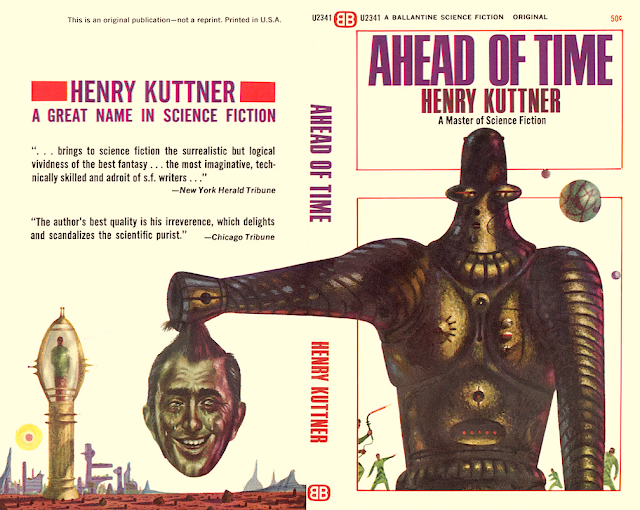 |
| CLICK TO ENLARGE |
'A brain in a box fights a criminal plot. A visitor from the future turns out to be peculiar even for his society. An eternal hillbilly family survives the centuries and gets into political trouble. A sick electronic calculator catches a psychosis from its operator.... These are some of the highly original and vividly written stories you will find in this selection of a master's work. Science fiction and fantasy grow constantly in popularity. Writing of this quality and imagination is the reason. Henry Kuttner demonstrates again in this book why more and more readers are becoming devotees of that intriguing fiction which is not content to stay in the world as we see it and know it, which takes us to the farthest reaches of space and time, to the farthest reaches of the human mind.'
'It is only 36 years from now. The streets, the buildings, the fields look just as they do today. And the people look the same--until you get close enough to see the bland, vacant stare in their eyes, to hear the empty guarded quality of their voices. They are victims of a gigantic con game. Free will, the right of dissent, have been washed away in a sea of slogans coined by the public-relations manipulators who have taken over the government. The rare ones who momentarily forget they are no longer individuals have their symptoms recorded by an enormous mechanical brain in Washington. The real dissenters, the incorrigible rebels, have their "sickness" cured by a simple surgical operation... This is the year of consent. And this is the story of a man who fought back.'
This 1976 softcover was Presley's first stint with Jack Williamson's The Humanoids, and robots in general. Later of course he would do a great followup for the novel's 1980 reprint (featured immediately below). Equinox, an imprint of Avon, published a series of trade softcover editions (digest sized really) of more or less famous works of science fiction, both novels and anthologies, under the label "SF Rediscovery." There were 27 titles in all, employing about a dozen different cover artists. Milton Glaser and George Leavitt's design layout, with its shaded all-caps font and box, was not a not a good selling point to a cover-art nerd like me; it tended to marginalize the mostly good art and just looked lousy overall. The actual artist's deserved bigger and better space.
'From far beyond Earth came a generation of benevolent robots whose sole purpose was to serve man by ending wars and easing his bodily and spiritual ills. Dr. Clay Forester, brilliant scientist and citizen of the distant future, had been recruited by a band of dissidents to stop the fledgling "brave new world." But why should he try to kill humanity's only hope for everlasting peace? A vagabond band of psychic anarchists are determined to defeat the invincible robots. And Clay Forester must discover the secret of the Humanoids and make an agonizing choice: fight for mankind's freedom to struggle and despair... or yield to the Humanoids' implacable imperative of total peace and pure bliss.'
'Tales of Wonder and Terror!: On "NEANDERTHAL PLANET the beings were both less than human and more than human. Now they had to decide which way to go!; If you fall into the wrong matrix of the past, present, or future you must beware of the choices you face. The sign is clear: DANGER-RELIGION!; INTANGIBLES, INC. could not be seen, but it ruled the lives---and deaths---of a couple and their children; SINCE THE ASSASSINATION a drug granting immortality is conceived; then moon visitors find that time is distorted. Would earth withstand such pressures?'
'Hank Stover had a feeling he wasn't in Kansas anymore. Hank Stover was one of the two people in the world who knew that Oz really existed... but he never expected to go there. He never expected his plane would be forced down by a green cloud that April day in 1923. Nor that he would meet the witch who had befriended his mother, Dorothy. Nor that she would be so beautiful...'
Scottish writer Iain Banks published 27 books, two of them posthumously after his premature death at the age of 59 in 2013. The British newspaper The Times named Banks in their list of "The 50 greatest British writers since 1945." Banks wrote mainstream works but enjoyed writing SF the most, creating a series of popular novels that he called the "Culture Series." In the UK he has been a frequent subject of both radio and television and was known to act in theater and voice spoken word audios.
'Count Sessine is about to die for the very last time... Chief Scientist Gadflum is about to receive the mysterious message she has been waiting for from the Plain of Sliding Stones... And Bascule the Teller, in search of an ant, is about to enter the chaos of the crypt... And everything is about to change... For this is the time of the Encroachment and, although the dimming sun still shines on the vast, towering walls of Serehfa Fastness, the end is close at hand. The King knows it, his closest advisers know it, yet still they prosecute the war against the clan Engineers with increasing savagery. The crypt knows it too; so an emissary has been sent, an emissary who holds the key to all their futures.'
Todd Schorr produced the cover art on Other Americas. If I had to describe Schorr's artwork in the 21st century it would be absurd, surreal and sometimes nightmarishly comic and dark--but I'm pretty bad at describing art and illustration other than by saying I like this piece better than that piece, and I happen to like quite a bit of Schorr's pieces, including and especially the ones he produced for books and magazine covers in the last century (mainly because they're more direct looking and less cluttered).
'Here is a whole panorama of strange and thrilling tales about the Earth in the years ahead when robots--man-like machines--threaten to control the world. Here are the headline stories of tomorrow when... Robots help man reach the stars, run for political office, out-think humans, rule the world, revolt against their human masters.'
'Carter Horton was the last of his kind. His three companions died in hibernation during the thousand-year journey from Earth. But Horton's beautiful new home held all sorts of wonderful surprises. There was an alien named Carnivore who claimed to have learned English from Shakespeare, a defective tunnel from the stars that allowed people---well, creatures---one-way access to the planet, a dragon in aspic... and a very odd, curved hill. And, of course, there was the terror that froze all minds at regular intervals.'
Isaac Asimov wrote Lucky Starr and the Big Sun of Mercury in 1956 using the pseudonym Paul French. It is the fourth of six volumes in Asimov's Lucky Starr series, all of them written for the juvenile market. The series may have been written in response to the success of Heinlein's juveniles, but it never resonated quite so well with fans. Supposedly as the series progressed it became more of a detective type of story, with the two leads practically mimicking Sherlock Holmes and Dr. Watson. Del Rey published this paperback edition in 1984.
'The barren crust of Mercury lay covered by a network of wire designed to harness the dazzling blaze of the sun and send it sizzling through hyperspace. But someone, or something, on the airless world was sabotaging the top secret mission. Where no life was said to exist, impossible "ghosts" had been seen, and murderous snakes of alien rock had condemned the innocent to death. It is to this troubled planet that Lucky Starr is sent by the powerful Council of Science. Who or where the enemy is... no one knows. And in order to find out, Starr must face the most deadly--and insane--opponent of his young career!'
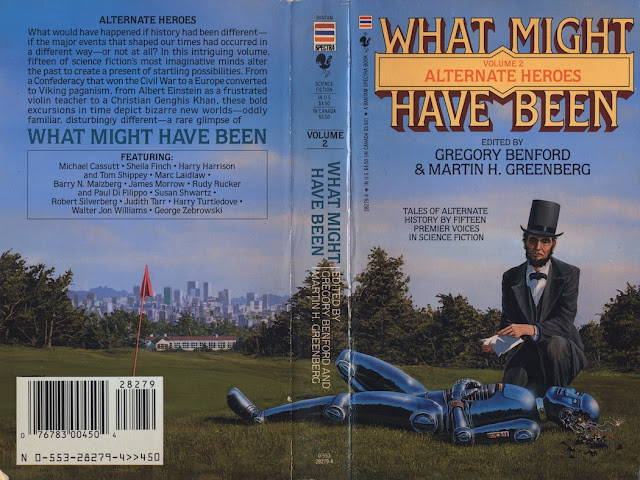 |
| CLICK TO ENLARGE |
This Ace edition was published in 1958 and it is the 2nd paperback appearance following the first one in 1954. That one had the infamous Richard Powers cover art that I've already featured above.
Cast of characters:
Jed Ambro: He was a hero who had to use the words and voice of a traitor.
Pop Ridgeway: A master mechanic who understood the music of the spheres.
Mr. Konar: No man knew the fullness of his secret power--and those who suspected could not talk.
Gail Tempe: Because she wanted the freedom of infinite space, she made herself the slave of a tyrant.
Ef: He was considered and idiot because he could only play chess in four dimensions!
X-81: A thing of polished metal and wires, it came along for more than the ride.
'Unable to remember his past, Dale Kelsey believes that the answer to his life's riddle is in Antarctica--the now-forbidden continent--and, with a price on his head searches for the one person who can help him find the truth.'

'Is there really a Merlin?" Everybody on the war-torn planet Poictesme believed it existed. And they all believed that when this super-gigantic computer was located amid the mountains of surplus equipment that was the planet's sole source of revenue, it would mean Utopia for everyone. Conn Maxwell knew different. He had studied the records on Earth and he thought he knew the true facts about this cosmic computer. To tell them would be to panic Poictesme, so instead he set about a new search in his own way---with starling results.'
 |
| CLICK TO ENLARGE |
'All of a sudden I was moving faster than usual. The other passengers standing on the subway platform seemed rooted to their places. It took me only seconds to reach the top of the six flights of stairs, and then I was out of the station and moving down Fulton Street at better than forty miles an hour! What was happening to me? It was as though I were the helpless passenger in a runaway car. Something else had assumed control and was guiding me. My body turned into an office building and raced down the corridor to a room where a man was sitting at a console. He'd begun to swing around in his chair when my mouth opened, and a thin, blood-red ray shot out, cleaving the man from head to abdomen. Then it was over. My mouth closed, and I stood there, stunned. Up to today I was Bob Tanner, an average, sane Citizen. Now what was I, man or murder machine?'
'Jack Williamson first created the Humanoids in 1947 in the novelette "With Folded Hand," which appeared in Astounding Science Fiction. The sequel, "And Searching Mind," followed in 1948. Now, after more than thirty years, the Humanoids have returned with that same sense of wonder and magic which has for so long characterized the fiction of Jack Williamson. The tattered remnants of mankind have fled to the distant parts of the universe in hopes of eveading the psychological imprisonment of the sleek robots. Driven only by their Prime Directive, "To serve and obey, and guard man from harm," they have patiently searched the stars for centuries to find those who hide to preserve their freedom. In THE HUMANOID TOUCH the human race is again confronted by, what were thought to be mythical creatures of colorless metal and ultimate power.'
Here's an interesting side note: a fellow artist named Andrew Rhodes copied Whelan's painting nearly verbatim and sold it to Arbor House in 1985 for use on Roger Zelazny's Trumps of Doom (ironic how that title is damningly prophetic for American Democracy right now). Whelan sued Arbor for plagiarism and the publisher was forced to make restitution. None of the other science fiction related covers that Rhodes produced seem to be plagiarizations though, or for that matter any of the other dozens of covers he produced prior to this infamous one, but what he did and where he went after this scandal broke is not really known.
The Ultimate Enemy was published in paperback by Ace in 1979, the fifth volume in Saberhagen's Berserker robot series.
'For countless millennia the dreadful Berserker fleets have ranged across the galaxy in a relentless war against all things living. Great irony is it indeed in this war of life against mechanism that while the purposes of Death are carried out by ultimately sophisticated devices, the cause of life is represented by one of the least evolved of intelligent species. For of all the starfaring races, only Man has brought with him untamed the heritage and instinct of battle; only Man can face The Ultimate Enemy.'
'A puzzling case of roboticide takes New York Detective Elijah Baley from Earth to the planet Aurora, where humans and robots have, till now, always coexisted in perfect harmony. Only the gifted roboticist Han Fastolfe had the means, the motive, and the opportunity to commit the crime---but Baley must prove the man innocent. For the murder of Jander Parnell is closely tied to a power struggle that will decide sho will be the next interstellar pioneers in the universe. Armed only with his own instincts, his sometimes quirky logic, and the immutable Three Laws of Robotics, Baley set out to solve the case. But can anything prepare a simple Earthman for the psychological complexities of a world where a beautiful woman can easily have fallen in love with an all-too-human robot?'
Like I said, only time will tell whether humanity will truly benefit from the controlling aspects of artificial intelligence and robotics, or suffer negatively because of its massive, world altering proliferation and almost certain autocratic grip. Have you forgotten the 2008 animated film Wall-E? If you have then go back and watch it again, it's certainly telling.
Stephen Youll (1965- ) and his twin brother Paul knew that they wanted to be artists at a very early age, and so they set about to make it happen. By the time they were 22 years old they were showing their artwork at the World Science Fiction Convention in 1987, which quickly opened the doors to the SF publishing world. Stephen's first cover assignment was for the American publisher Bantam, in 1988. In just a few years he was elevated to producing covers for Asimov reprints, of which this 1991 Bantam reprint edition of I, Robot was one of. Since then he's barely had time to catch his breath.
'Isaac Asimov changed our perception of robots forever when he formulated the classic laws governing their behavior. In I, Robot Asimov chronicles the development of the robot from its primitive origins in the present to its ultimate perfection in the not-so-distant future---a future in which humanity itself may be rendered obsolete. Here are stories of robots gone mad, mind-reading robots, robots with a sense of humor, robot politicians, and robots who secretly run the world, all told with the dramatic blend of science fact and science fiction that has become Asimov's trademark.'
Isaac Asimov's THREE LAWS OF ROBOTICS:
1. A robot may not injure a human being or, through inaction, allow a human being to come to harm.
2. A robot must obey the orders given it by human beings except where such orders would conflict with the First Law.
3. A robot must protect its own existence as long as such protection does not conflict with the First or Second Law.
If there is a loophole in Asimov's three laws, it is the development of the Zeroth Law, which directs a robot to look out for all of humanity, in preference to one person.
Interestingly enough, for the 1986 tribute anthology, Foundation's Friends, Harry Harrison wrote a story entitled, "The Fourth Law of Robotics." This Fourth Law states: "A robot must reproduce. As long as such reproduction does not interfere with the First or Second or Third Law."
"Unfortunately robots capable of manufacturing robots do not exist. That would be the philosopher's stone, the squaring of the circle."
 |
| I, Robot by Isaac Asimov. Signet 1964. Cover artist unknown |

















.WarWithTheRobots.Wings.RichardCourtney.art.a.jpg)

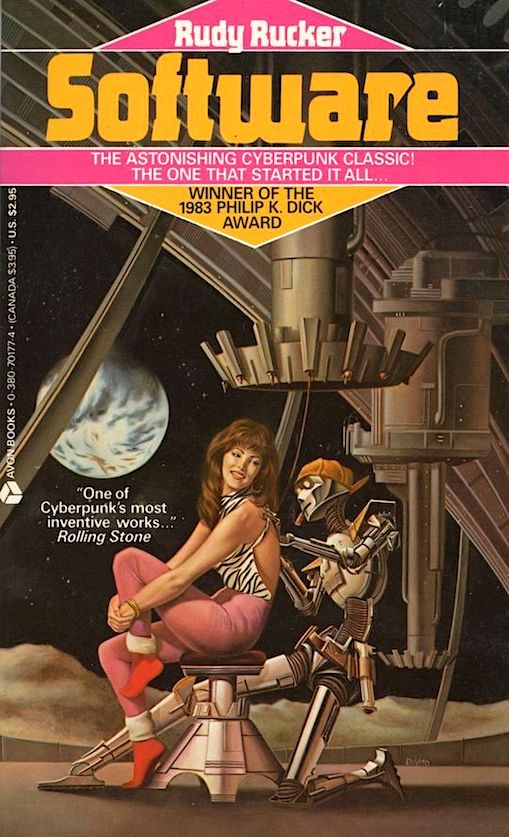








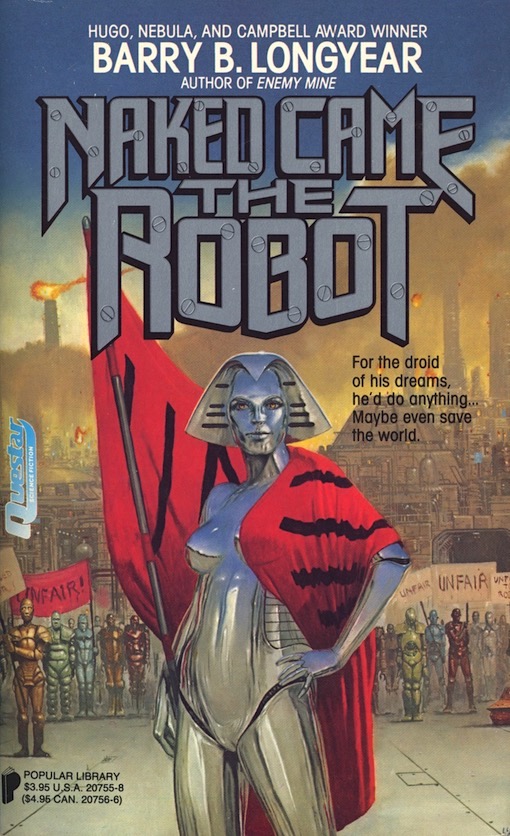



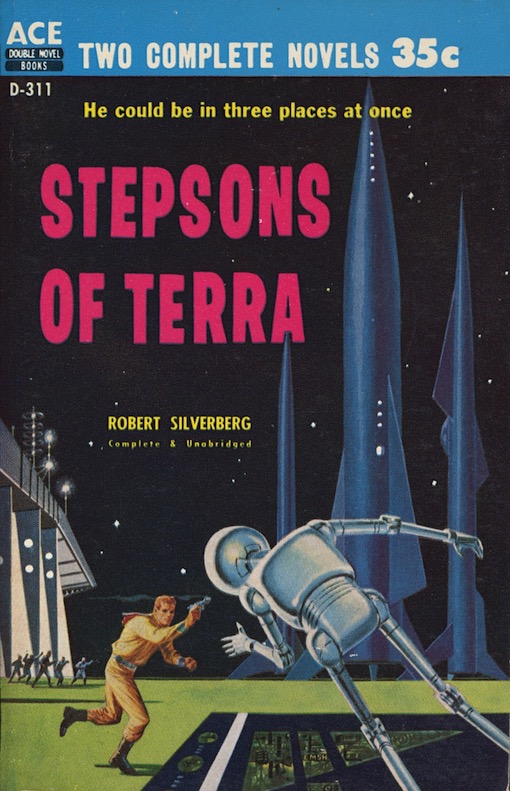















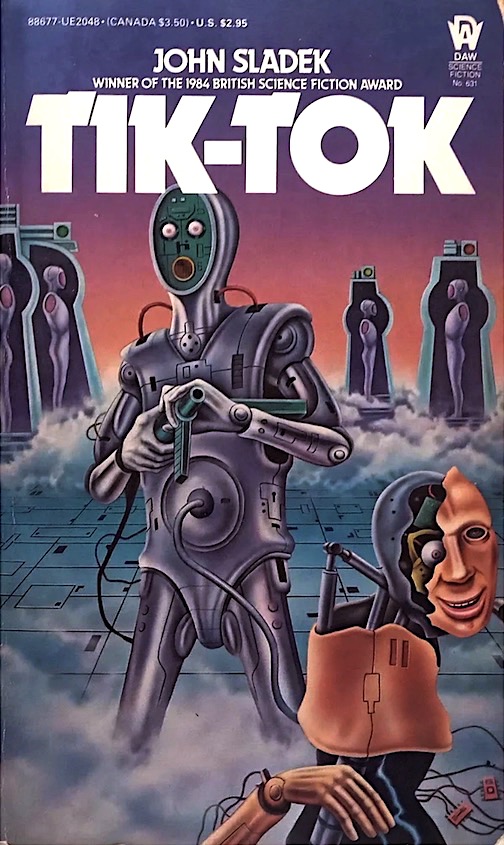

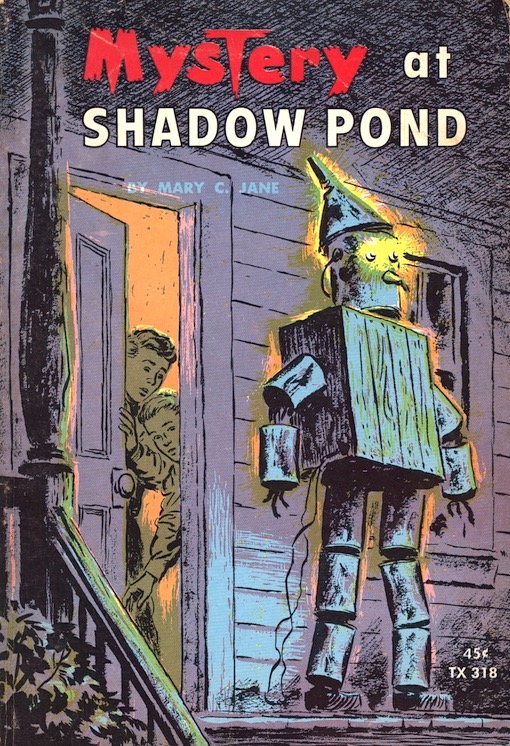























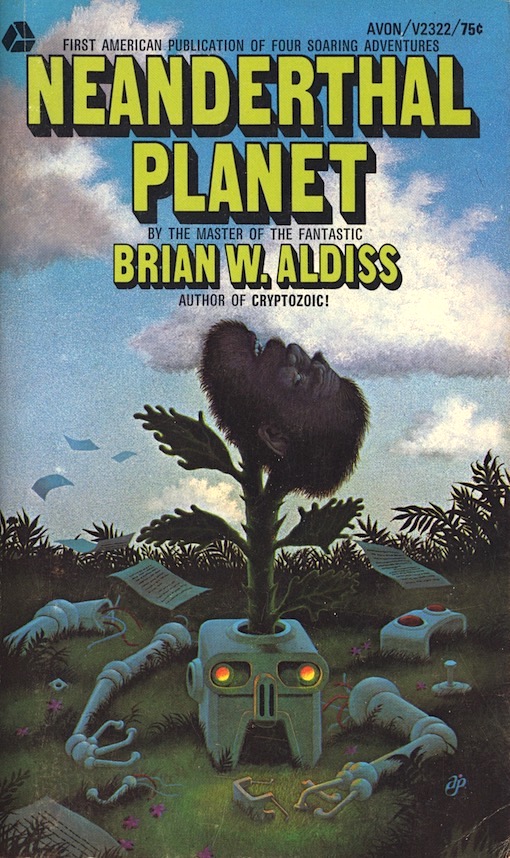










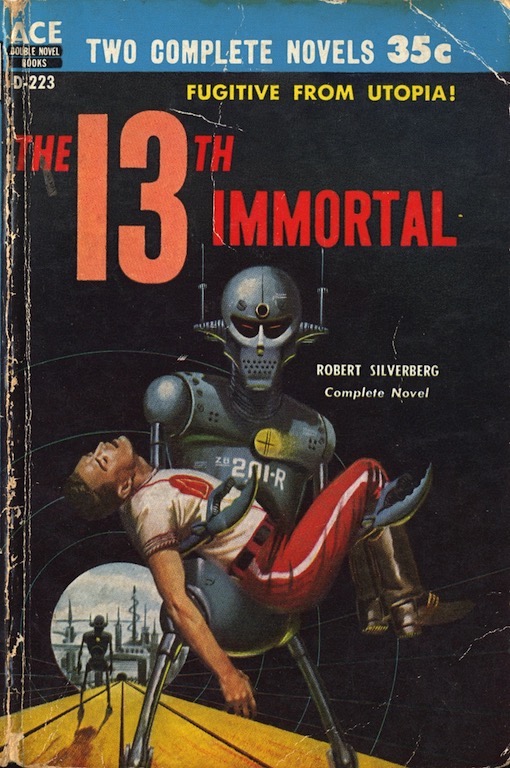


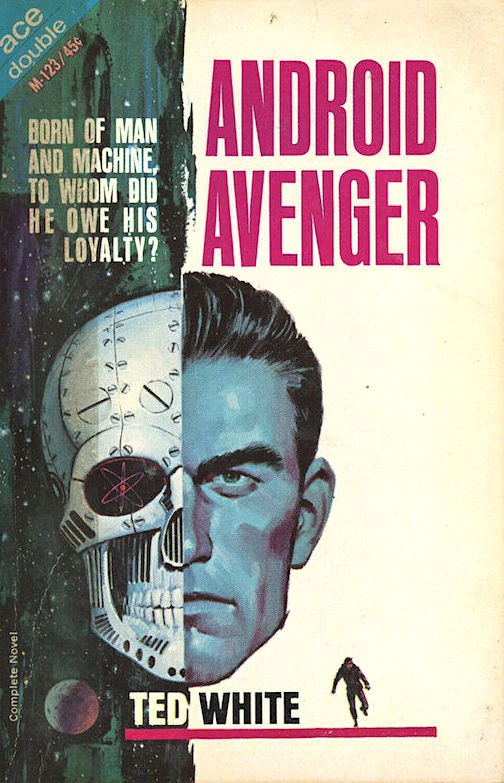
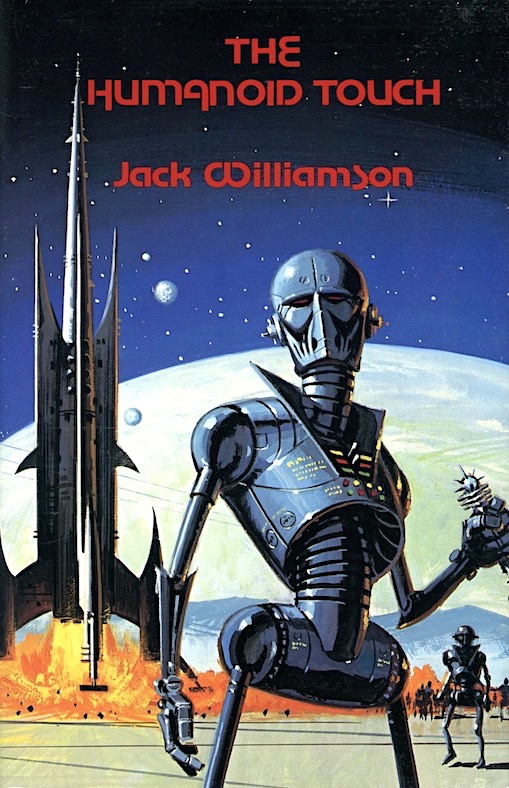

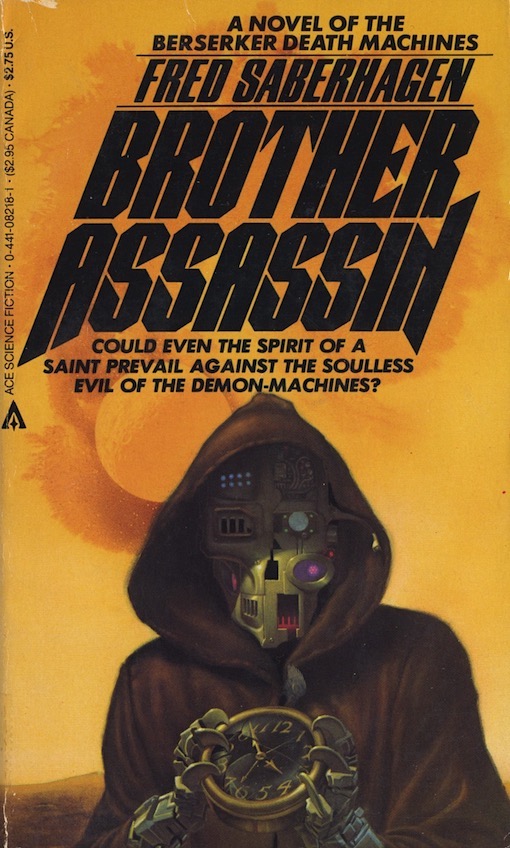








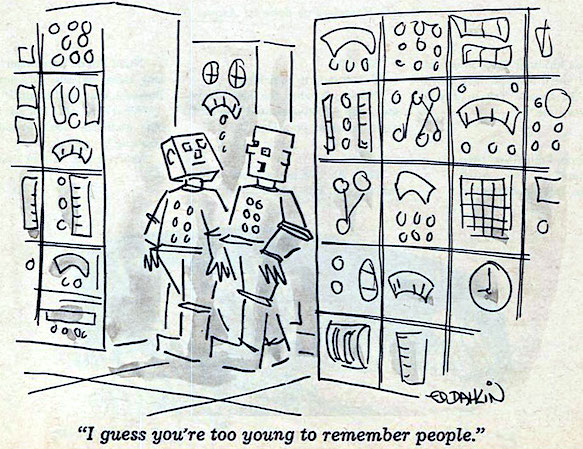
No comments:
Post a Comment